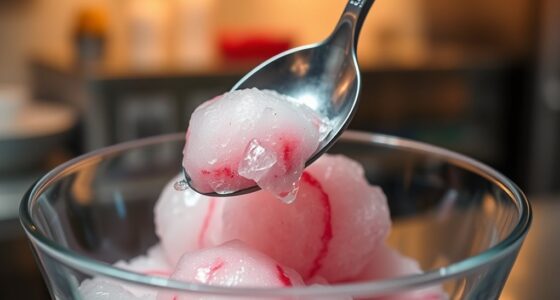Hard ice cream sells more than soft serve, especially across diverse regions and demographics. It offers longer shelf life, rich flavors, and wider variety, appealing to a broad audience. Soft serve is popular for quick service and lower costs but doesn’t match hard ice cream’s market share. If you want to find out what makes the differences impact sales more deeply, keep exploring the details.
Key Takeaways
- Hard ice cream generally holds a larger market share, around 65%, compared to soft serve’s approximately 35%.
- Hard ice cream dominates sales due to its longer shelf life, broader flavor variety, and premium ingredient appeal.
- Soft serve is favored for quick service and lower costs, but its sales volume is typically lower than hard ice cream.
- Regional and demographic preferences influence which type sells more in specific markets, like gelato in Italy versus soft serve in the US.
- Seasonal peaks boost sales for both, but warm months and holidays usually see higher overall sales for hard ice cream.
Overview of Soft Serve and Hard Ice Cream
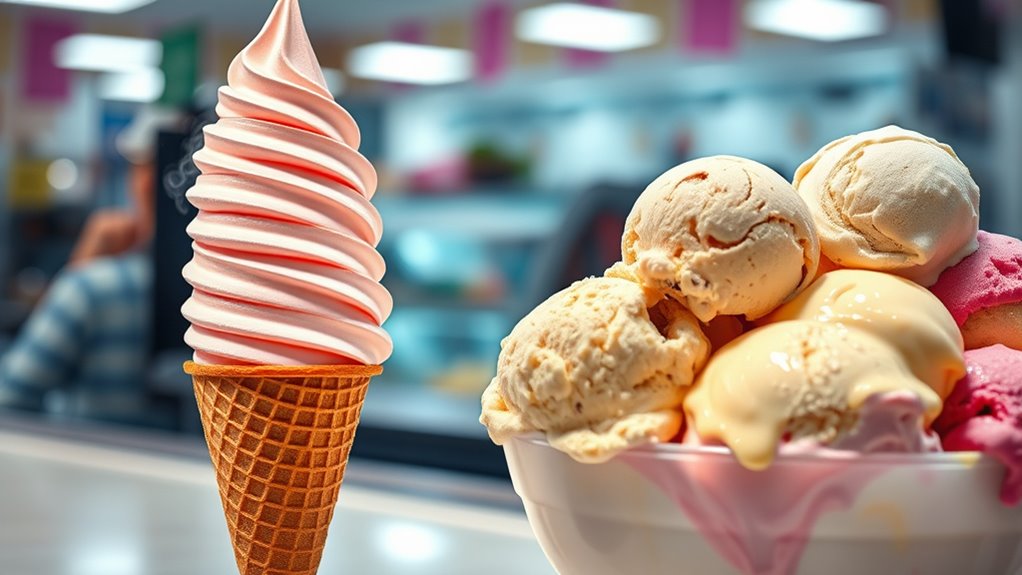
Soft serve and hard ice cream are two popular frozen treats that differ mainly in texture, production process, and serving style. Soft serve is known for its creamy, smooth texture, achieved through continuous freezing and air incorporation, making it easy to serve directly from machines. Hard ice cream, on the other hand, involves a longer freezing process with less air, resulting in a denser product. Over time, flavor innovation has led to unique varieties for both types, appealing to diverse tastes. Packaging advancements have also played a role in their popularity, with soft serve often served in cones or cups, while hard ice cream benefits from improved cartons and containers that preserve freshness. These developments help cater to consumer preferences and expand market reach. Additionally, frozen dessert varieties continue to evolve with novel techniques and ingredients, further enriching the market options. Furthermore, the production methods for each type significantly influence their texture, flavor, and overall consumer appeal, with ongoing technological innovations driving improvements in quality and diversity. Moreover, consumer preferences are increasingly shaped by health trends and dietary needs, influencing product development in both categories.
Historical Trends in Ice Cream Sales
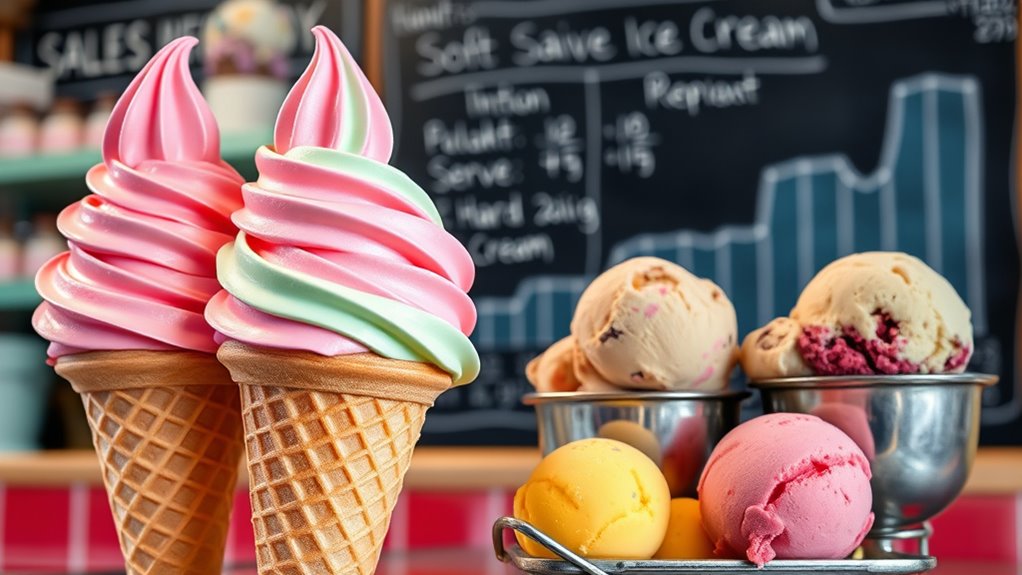
You’ve probably noticed ice cream sales fluctuate with the seasons and trends. Over time, certain flavors and types gain or lose popularity, shaping the market. Understanding these patterns helps you see how consumer preferences evolve and influence sales. Additionally, emerging market trends such as health consciousness and flavor innovation continue to impact consumer choices and overall sales. Recognizing sales fluctuations caused by external factors can help businesses adapt their strategies for better performance. Furthermore, the decor and presentation of ice cream products can significantly affect consumer appeal and purchasing decisions, especially as visual aesthetics become increasingly important in marketing. Moreover, consumer behavior plays a crucial role in determining which ice cream varieties thrive in different periods, influenced by factors like air quality that affect overall well-being and preferences.
Seasonal Sales Fluctuations
Have you ever noticed how ice cream sales tend to spike during certain times of the year? Seasonal fluctuations are driven by weather, holidays, and consumer trends. Typically, summer sees the highest sales, especially in warm months when people crave cool treats. During these peaks:
- Flavors differentiation becomes key, with brands offering seasonal flavors like pumpkin or peppermint.
- Packaging innovations, such as single-serve or eco-friendly containers, appeal to impulse buyers.
- Promotions and limited-time offers boost sales during holidays like July Fourth or Christmas.
- Portable refrigeration options, like compact freezers or coolers, enable vendors to keep products fresh and appealing in various settings. Incorporating seasonal marketing strategies can further enhance sales during peak periods.
Understanding these patterns helps brands adapt their strategies, emphasizing seasonal flavors and innovative packaging to maximize sales during high-demand periods. Recognizing these fluctuations guarantees you can meet customer needs when they’re most enthusiastic for ice cream.
Popularity Over Time
Looking at how ice cream sales have changed over the years reveals interesting patterns and shifts in consumer preferences. Gelato popularity has risen steadily, especially among health-conscious consumers seeking lower-fat options. Meanwhile, dairy alternatives like almond, coconut, and oat-based ice creams have gained traction, reflecting growing demand for vegan and lactose-free products. Traditional hard ice cream and soft serve still dominate sales, but their market shares fluctuate as trends evolve. During the early 2000s, natural and artisanal varieties surged, and more recently, plant-based options have seen rapid growth. These shifts indicate that consumers are increasingly seeking diverse textures, flavors, and dietary options, shaping the overall landscape of ice cream sales over time. Additionally, consumer preferences continue to evolve as health trends and dietary restrictions influence purchasing decisions. Innovations in product development and the rise of innovative marketing strategies contribute to the dynamic nature of the market, including the incorporation of sustainable ingredients that appeal to environmentally conscious buyers. Furthermore, the market landscape is influenced by global trends and technological advancements that enable new flavor creation and production methods.
Popularity Across Different Demographics

You’ll notice that different age groups favor different types of ice cream, with kids often preferring soft serve and older adults leaning toward hard ice cream. Regional taste trends and cultural influences also shape preferences, making certain flavors or textures more popular in specific areas. Understanding these demographic differences helps explain why soft serve and hard ice cream each have their loyal fans. Additionally, texture preferences can vary significantly across demographics, further influencing sales patterns. For example, the sensory experience associated with creamy textures often appeals more to certain age groups, shaping their choices. Recognizing these consumer behavior patterns can help vendors tailor their offerings to different markets. Moreover, cultural influences can play a significant role in shaping flavor and texture preferences, impacting sales strategies. Incorporating market segmentation insights allows businesses to better meet regional demands and enhance overall sales performance.
Age Group Preferences
Different age groups show distinct preferences when it comes to soft serve and hard ice cream, reflecting their unique tastes and eating habits. You’ll find that:
- Young children often favor soft serve for its creamy texture and fun presentation, despite its slightly higher sugar content.
- Teens and young adults prefer hard ice cream for its variety of flavors and nutritional content, which can include added protein or lower fat options.
- Older adults tend to choose hard ice cream, considering its environmental impact and familiarity, along with a preference for healthier or more natural ingredients. Additionally, yogurt-based ice creams have gained popularity among health-conscious consumers across age groups.
- Additionally, the perception of ice cream quality and ingredients influences preferences, as consumers become more aware of ingredient differences such as milkfat content and additives. The Weight of Wind Turbine Blades can also indirectly shape consumer attitudes toward sustainable choices, influencing preferences for environmentally friendly products. Understanding consumer behavior is crucial for businesses aiming to cater to these diverse tastes.
These preferences influence sales and availability across age groups. As you consider trends, remember that environmental impact and nutritional content heavily sway consumer choices in each demographic.
Regional Taste Trends
Regional taste trends markedly influence the popularity of soft serve and hard ice cream across various demographics. Your preferences often align with local flavor preferences, which shape what types of ice cream sell best in each area. For example, certain regions favor fruity or dairy-rich flavors, while others lean toward more unique or spicy tastes. Local ingredient sourcing also plays a pivotal role, as communities prefer products made with fresh, regional ingredients, enhancing flavor authenticity. These regional differences affect whether soft serve or hard ice cream dominates sales, depending on local tastes. By understanding how regional flavor preferences and ingredient sourcing impact consumer choices, you can better tailor your offerings to meet the specific demands of each market, boosting sales and customer satisfaction.
Cultural Influences
Cultural influences profoundly shape the popularity of soft serve and hard ice cream among various age groups, ethnic communities, and social backgrounds. Your culinary traditions and cultural preferences determine which type feels more familiar or special. Consider these factors:
- In regions where traditional desserts like gelato or frozen yogurt dominate, hard ice cream may be more popular.
- Countries with a history of street food and quick treats often favor soft serve for its convenience.
- Family traditions and celebrations can sway choices, with some cultures favoring one style over the other for festivals or gatherings.
Understanding these cultural influences helps explain why certain demographics lean toward soft serve or hard ice cream, reflecting deeper culinary traditions and social norms.
Factors Influencing Consumer Preferences

Consumer preferences for soft serve and hard ice cream are shaped by a variety of factors, including taste, texture, convenience, and perceived quality. Flavor innovation plays a vital role, as new and exciting flavors can sway your choice toward one type over the other. If you enjoy trying unique and inventive flavors, soft serve often appeals due to its adaptability. Packaging preferences also influence your decision; easy-to-handle cups and cones make soft serve more convenient, while traditional tubs appeal to those seeking at-home treats. Additionally, your perception of quality, freshness, and presentation impacts what you buy. Overall, these factors combine to shape your preferences, guiding you toward the ice cream type that best fits your taste, lifestyle, and expectations.
Market Share and Sales Data Analysis

You’ll notice how market penetration trends reveal which type of ice cream is gaining popularity across regions. Comparing sales volumes helps you understand which product dominates in different markets. Analyzing this data gives you a clear picture of overall consumer preferences and industry shifts.
Market Penetration Trends
Market penetration trends reveal that hard ice cream continues to dominate sales in many regions, capturing a significant share of the frozen dessert market. You’ll notice that brands succeed through strategies like:
- Emphasizing flavor innovation to attract consumers seeking novel tastes.
- Improving packaging strategies to enhance convenience and shelf appeal.
- Expanding distribution channels to reach more locations.
While soft serve offers quick service, hard ice cream’s ability to adapt with new flavors and eye-catching packaging keeps it ahead. These tactics help brands increase market share and maintain dominance. As consumer preferences evolve, companies focus on flavor innovation to stand out and packaging strategies to improve accessibility. This ongoing trend ensures hard ice cream remains the leader in market penetration, even as soft serve gains popularity in specific segments.
Sales Volume Comparison
When comparing sales volumes and market shares, hard ice cream consistently outpaces soft serve in overall revenue across many regions. Its established ice cream branding and wide flavor innovation appeal attract a diverse customer base. To illustrate, here’s a snapshot of market data:
| Brand | Market Share (%) | Average Sales Volume (Units) |
|---|---|---|
| Hard Ice Cream | 65 | 1,200,000 |
| Soft Serve | 35 | 650,000 |
| Total | 100 | 1,850,000 |
| Growth Rate (Y/Y) | 3% | 2.5% |
Hard ice cream’s stronger sales reflect its broader flavor options and sustained branding efforts, keeping it ahead of soft serve in sales volume.
Regional Variations in Ice Cream Consumption
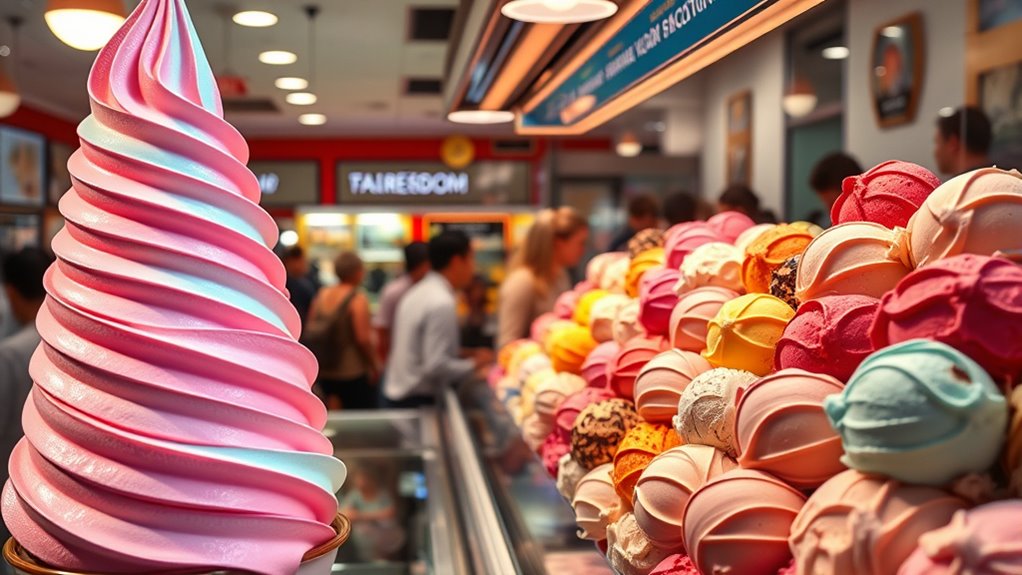
Regional preferences markedly influence ice cream consumption patterns around the world. Your choices are shaped by local flavor preferences and ice cream traditions. For example:
- In Italy, gelato’s rich, creamy texture and regional flavors like pistachio dominate.
- In Japan, matcha and mochi-based ice creams reflect local tastes and traditions.
- In the U.S., there’s a strong preference for variety, with soft serve and classic flavors like vanilla and chocolate thriving.
These variations highlight how local ingredients, cultural habits, and culinary history impact what types of ice cream are popular. Whether it’s dairy-heavy traditions in Europe or fruit-based frozen treats in tropical regions, understanding regional differences helps explain why certain ice cream styles outsell others in specific areas.
Seasonal Impact on Sales Volumes
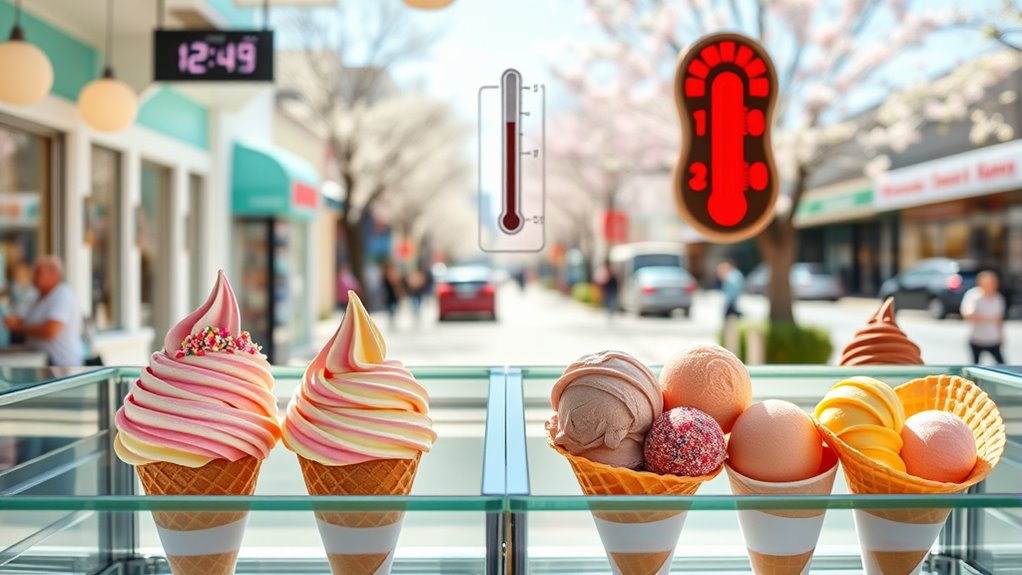
Seasonal changes profoundly influence ice cream sales, with warmer months typically seeing a surge in demand. During summer, you’ll notice increased sales driven by outdoor events and holiday promotions that boost visibility. To capitalize on this, packaging innovations become essential, making products more attractive and portable for consumers on the go. Seasonal marketing campaigns, like special flavors or limited-edition packaging, directly drive sales spikes. Conversely, colder months usually see a dip, but strategic promotions can sustain interest. Understanding these seasonal patterns helps you plan inventory, marketing, and product presentation more effectively. By aligning your offerings with seasonal trends and leveraging holiday promotions and innovative packaging, you can maximize sales volume throughout the year.
Cost and Price Differences Between Types

Choosing between soft serve and hard ice cream involves understanding their cost structures and pricing differences. Typically, soft serve has lower production costs because it requires less labor and equipment, leading to more flexible pricing strategies. Hard ice cream, on the other hand, incurs higher costs due to ingredients, storage, and longer production times. To compare:
- Production costs: Soft serve’s simpler process reduces expenses.
- Pricing strategies: Soft serve often uses smaller profit margins but higher volume sales.
- Consumer pricing: Hard ice cream tends to be priced higher per serving because of richer ingredients and premium positioning.
These cost differences impact how vendors set prices, influencing which type sells more based on profit margins and customer preferences.
Innovation and New Flavors Driving Sales
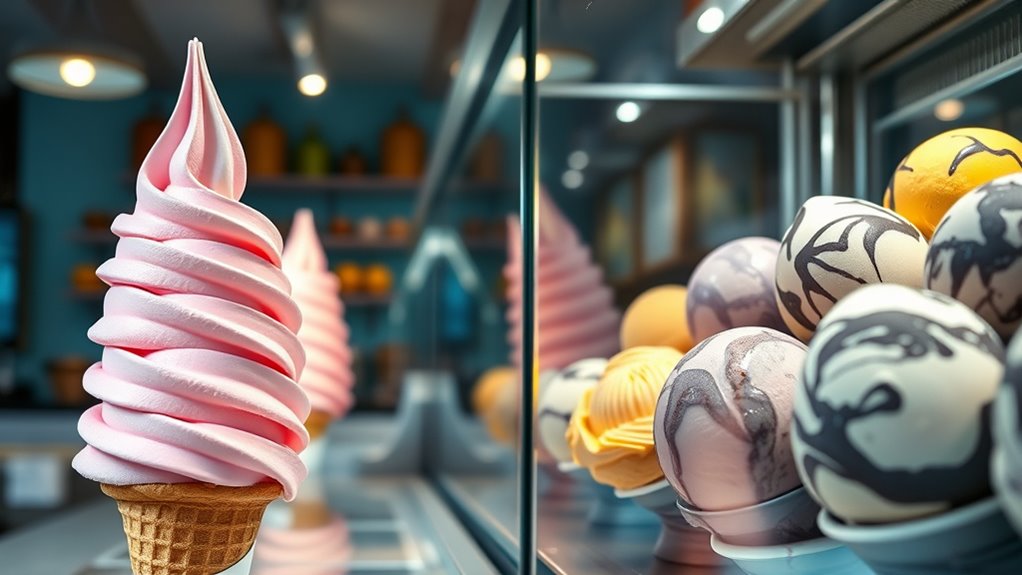
Innovation and new flavors are transforming the ice cream market, enticing you with exciting options that stand out from traditional offerings. Flavor innovations like matcha, lavender, or spicy varieties attract adventurous customers enthusiastic to try something fresh. These creative flavors generate buzz and boost sales by appealing to diverse tastes. Packaging trends also play a vital role, with eye-catching designs and eco-friendly materials making products more appealing on shelves. Unique packaging attracts attention and enhances the perceived value of new flavors. By continuously evolving with innovative flavors and attractive packaging, brands can differentiate themselves and draw in more customers. This dynamic approach keeps the market lively and encourages consumers to explore new options, ultimately increasing sales for both soft serve and hard ice cream.
Future Trends in Ice Cream Consumption

As consumers continue to seek new and exciting flavors, the future of ice cream consumption will be shaped by changing preferences and technological advancements. You can expect a focus on sustainability and health-conscious choices, such as:
- Increasing demand for vegan options that satisfy taste and texture without animal products.
- Adoption of sustainable packaging to reduce environmental impact.
- Innovations in preservation and delivery methods, making ice cream more convenient and eco-friendly.
These trends mean you’ll see more plant-based flavors and eco-conscious packaging in stores. Companies will prioritize transparency around ingredients and sustainability efforts, aligning with your values. As technology advances, expect personalized flavors and better environmental practices to influence your purchasing decisions. The future of ice cream is all about meeting your evolving tastes while protecting the planet.
Frequently Asked Questions
How Do Texture and Taste Influence Consumer Choice?
When choosing ice cream, your flavor and texture preferences play a big role. If you love smooth, creamy textures, you might prefer hard ice cream, which offers richer flavors. On the other hand, if you enjoy a lighter, softer feel, soft serve appeals more. Your taste buds and texture preferences influence your choice, making you lean toward the type that delivers your ideal flavor experience every time.
What Role Do Marketing Strategies Play in Sales Differences?
Marketing strategies play a vital role in boosting sales. You can leverage branding strategies to create a strong identity that attracts customers and builds loyalty. Additionally, seasonal promotions generate excitement and encourage impulse purchases during specific times of the year. By combining compelling branding with timely promotions, you influence consumer choices effectively, increasing sales regardless of product type. Your strategic marketing efforts can profoundly impact which ice cream type sells more.
Are There Specific Health Benefits Associated With Each Type?
Imagine you’re at a soda fountain in the 1950s—both soft serve and hard ice cream have unique health perks. Soft serve often has fewer calories and lower fat, making it a lighter choice for dietary considerations. Hard ice cream, however, provides more nutritional differences, like higher protein and calcium. Your decision depends on your health goals; both can fit into a balanced diet if enjoyed mindfully.
How Do Packaging and Serving Sizes Affect Purchasing Decisions?
Packaging appeal and serving size influence your purchasing decisions markedly. Eye-catching packaging grabs your attention and makes you more likely to choose a product. Smaller servings might appeal if you’re watching portion sizes or seeking a snack, while larger ones seem better for sharing or value. Ultimately, attractive packaging and appropriate serving sizes guide your choice by offering convenience, perceived value, and satisfying portion expectations.
What Impact Does Social Media Have on Ice Cream Popularity?
Social media markedly boosts ice cream popularity through viral trends and influencer impact. When you see your favorite influencer enjoying a new flavor or creative toppings, you’re more likely to try it yourself. Viral videos and posts generate excitement, making certain brands or types, like soft serve or hard ice cream, more appealing. Social media creates buzz, drives demand, and influences your purchasing choices by showcasing the latest and tastiest options.
Conclusion
If you’re wondering which ice cream type sells more, soft serve takes the lead, accounting for over 60% of ice cream sales in many regions. Its quick preparation and variety of flavors attract a broad audience year-round. With innovations like premium ingredients and unique toppings, soft serve continues to grow in popularity. So, next time you’re at a scoop shop, you’re probably choosing the more popular option that’s winning in sales!


